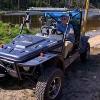Fuel Tanks & Mods
-
Similar Topics
-
By FTG-05
I want to ditch my Kubota RTV-XG850 and its moronic twitchy throttle design flaw, get rid of the problematic engine and the 40 mph purposely throttled speed.
So far, I'm looking at the Honda Pioneer 1000 and the Polaris Ranger 1000, both of which have 1000-1500 lb payload bed capacity.
What other makes and models should I be looking at?
Thanks for the help!
-
By SpaceGhost
As with any forum you join, there is a requirement for an obligatory introduction... and that seems fair. How else do you get that first post in there without jumping in with some stupid question right out of nowhere?
Hi. I'm Space Ghost. Well, not really, but that was my call sign on my last deployment before an IED made me non-deployable, and I an now retired/disabled, and living on my wonderful VA disability. I did almost 28 years in total between the Army, Army Reserve, and National Guard. 1 deployment with the Reserve (Desert Storm) and 3 with the Guard (1 pre, and 2 post 9/11)
Married (going on 30 years) one of each. (both out of the nest)
Just picked up my first side by side a couple days ago. A 2020 Can-Am Defender HD10 DPS 6x6.
It's in pretty good shape, but as you can probably tell, it's sitting a bit high. Former owner put a lifting collar on the shocks.
The good = almost 17" of ground clearance. (30" tires)
The bad = incredibly steep driveline angles, and a pretty stiff ride.
They will be coming off.
Other than that... clean as a pin and appears very well maintained.
Looking forward to seeing what this forum can bring, and hoping I can bring something in return.
-
By weasel
starts up you have keep rpms up for 5 minutes till it warms up then runs fine. But if it stalls wont start unless you unplug fuel pump and hold it to the floor till it starts then plug pump back in and run it till it warms up then it is fine all day.
-
By Jim Kessell
2005 American Landmaster
EH65 Subaru Robins
spits fuel from breather hose into the air cleaner and then down into carb. What’s causing this ??
-
-
By Prepper
Hello All...
Just bought a 2014 Massimo 500 UTV. It;s not running at the moment, but hopefully will soon. I need a seat for it also (passenger side, if it makes any difference.) It is a crank-but no start situation. Just now starting to read the boards for solutions. Apparently these models are well known for this issue. If anyone has any suggestions, please feel free to chime in, it would be greatly appreciated.
Thanks
-









Recommended Posts
Join the conversation
You can post now and register later. If you have an account, sign in now to post with your account.
Note: Your post will require moderator approval before it will be visible.